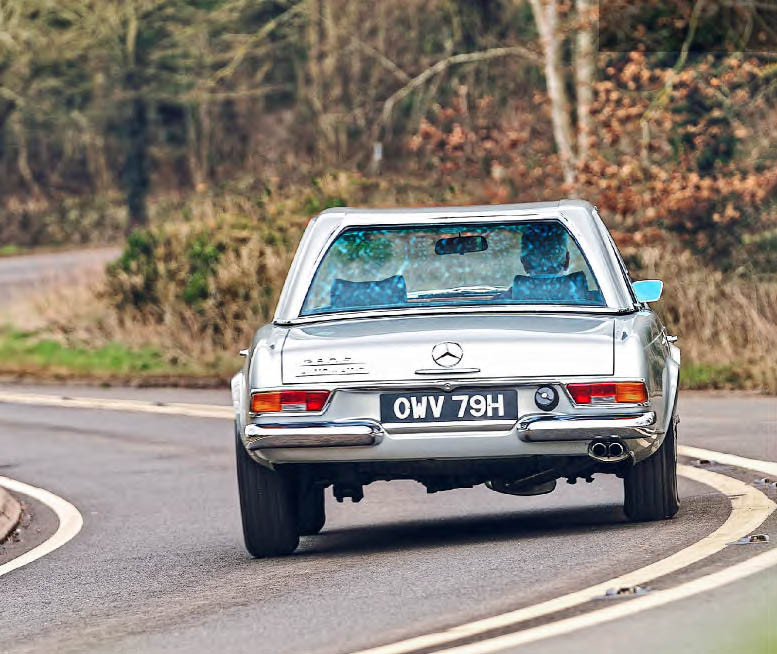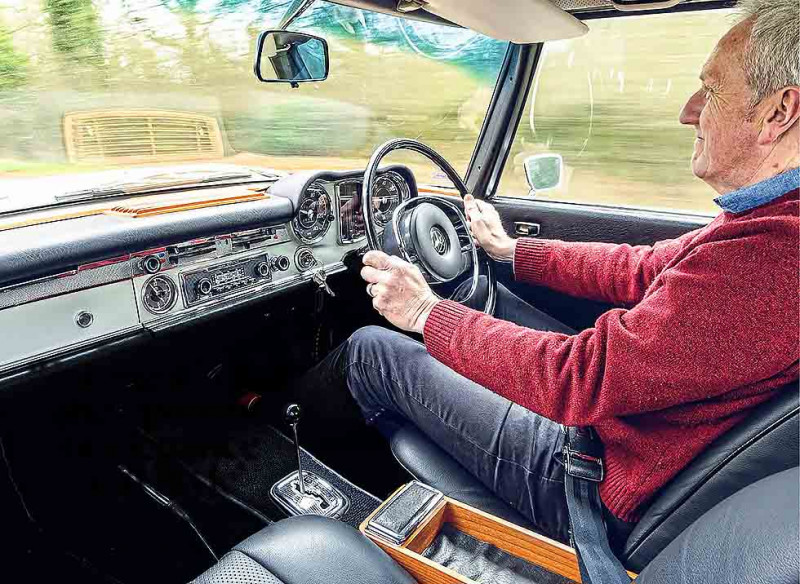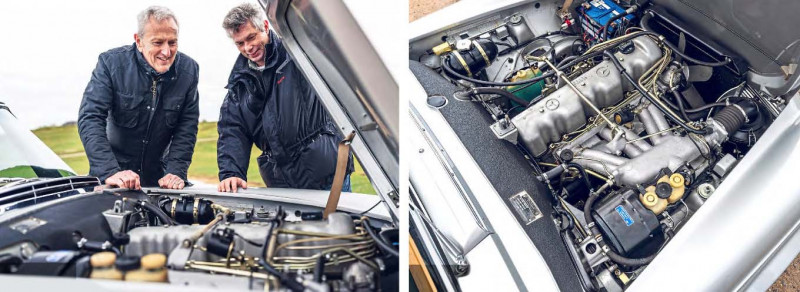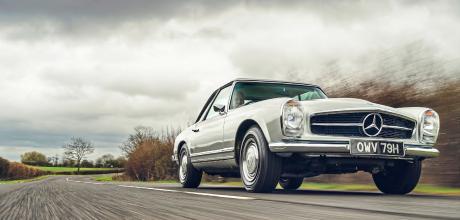1969 Mercedes-Benz 280SL Automatic W113
Classic Cars reader David Driscoll has always dreamt of driving a W113 Mercedes-Benz SL. Today we put him beneath the Pagoda hardtop of a reference.
Words ANDREW NOAKES
Photography JORDAN BUTTERS
The List Will British sports car fan David Driscoll succumb to the Mercedes-Benz SL’s charms?
‘For me it’s just the epitome of elegance and style’

How will a ‘Pagoda’ SL feel to our reader after a lifetime of British sports cars?
Minis are huge fun to drive but even the most ardent fan would admit they’re not the ideal car for a long journey. But Classic Cars reader David Driscoll has just stepped out of his after a three-hour stint with a huge smile. That’s probably because he’s looking forward to driving one of his all-time dream cars, which is why we’ve arranged to meet at the Mercedes mecca that is The SL Shop near Stratford-upon-Avon. Today David’s going to swap his Mini for a beautiful Pagoda-roof Mercedes-Benz SL.

‘For me it’s just the epitome of elegance and style,’ he says as we cast an eye over the line-up of Pagoda SLs in the SL Shop showroom. ‘It has a fantastic elegance that very few cars have today. It’s a sort of totally different mindset of automotive design. Today they keep on adding extra creases or curves or whatever. The SL is so restrained in comparison. It was about how little they could add and yet still make it look interesting. The fact that there’s so little adornment, no additional jewellery on the car, is what I think makes it look amazing.’
‘You get in it, you drive it, it’s dead easy. But you also get the feeling that it’s capable of a lot more and you have to be prepared to search for it’

Our car for the day is one of the last of the W113s, a 1969 280SL that, on this chilly spring day, is wearing the ‘Pagoda roof’ hardtop the model is famous for. ‘This was from an era where a design was really by one person,’ says David as we head out to the SL. ‘The Mini was all Issigonis, and nobody else could touch it unless he said so. The Pagoda styling was a masterpiece by Paul Bracq. Everything about it says this hasn’t had an army of people fiddling with it. This is someone with an eye for design who’s drawn a few lines and then been allowed to deliver those lines all the way to the final car. I own a TR7 and, when you look at Harris Mann’s original sketches for that or the Princess, they’re remarkably attractive, but you can see that someone else has then come in and they’ve lost the original essence in the production car. You don’t get that sense with the Pagoda. It has retained the essence of the car from the original drawing.’
‘This was from an era where a design was really by one person. It’s retained the essence of the original drawing’
David takes a walk around the SL, absorbing the details of its design. ‘The headlamps are all of a piece with the indicators, which cleans up the front end enormously compared to what else was on the road when this design appeared in 1963. It actually has a remarkably short wheelbase, but it’s quite wide because it carried over its running gear from the Fintail saloon.’ David points out the chrome-rimmed rear lights, which are a mite fussy by comparison with the clean lines of the rest of the exterior. ‘But because they didn’t take the bumper all the way across – it just has quarter bumpers – the tail doesn’t look too heavy or out of scale with the rest of the car,’ he says. ‘This one is 54 years old and it’s a good example that has been well kept. It’s just as it came out of the factory and it looks perfect.’

David swings open the wide driver’s door to get behind the wheel. ‘It feels solidly built, just as you’d expect from a Mercedes,’ he reports. The interior has the same sort of understated appeal as the exterior: businesslike and built from quality materials but not ostentatiously luxurious. Only some sparse wooden trim gives any indication that this is a car that cost almost twice as much as a Jaguar E-type. But David finds that the seat is comfortable and there’s plenty of space for his six-foot frame to get comfortable in the cabin. Typically for a Mercedes the steering wheel is on the large side, and there’s an automatic gear selector with a gate that’s the reverse of the typical modern pattern, but David is soon used to it all. ‘The steering doesn’t feel overly light. I’ve driven really light power steering on a Jaguar where you could turn the wheel with one finger, and there was no feel through the rim. This isn’t like that at all – you can feel the road through the steering wheel, which gives you a lot of confidence. It has a great turning circle too.’
The SL is proving to be a car that it’s easy to feel at home in. ‘With some cars you’re sort of dominated by them for the first few miles,’ says David. ‘This isn’t like that. It’s a very easy car to get used to and be confident in. You get in it, you drive it, it’s dead easy to see out of and it’s all fine. But you also get the feeling that it’s capable of a lot more and you have to be prepared to search for it. I’d love to live with one for a week or longer, because I think I’d discover more and more things about it and how capable it is, which are almost hidden at first sight. It’s a car that you could really appreciate more over time.’

We’re heading for some good driving roads, but there’s a bit of traffic to deal with first. Trundling through town with the moderns the fuel-injected 2.8-litre six proves to be as docile and well-mannered as you could wish for, and the automatic transmission makes life easy. ‘Older cars can be a bit of a pain when you’re in the cut and thrust of ordinary traffic,’ says David.
‘You don’t have any of that with the SL. It is a car from the early Sixties that you would say you could very comfortably use every day, without feeling that you’re going to get in other people’s way. The biggest problem you have is people with camera phones trying to take pictures of it.’
There’s rain in the air, and David hunts for a switch to turn on the windscreen wipers. ‘It’s on the end of the column stalk. It’s a very modern action – push it in to start, push it in again to turn them off. Much better than the enormous dashboard switch many cars of this era would have.’ He loves the acrobatic claphands action of the wipers, their spindles near the corners of the windscreen. ‘They look wonderful in motion and they’re very efficient in the way they work. But you wonder who in their right minds designs wipers that have to be timed so that they fold at exactly the right moment. There has got to be an easier way, surely!’
The rain has ebbed away and the roads are opening out now, giving David a chance to explore the SL’s performance. ‘It’s probably an autobox from the Fifties and you do feel the gearchanges, but it isn’t unpleasant. In normal driving, once it’s in fourth gear it’s reluctant to change down on its own. But I’ve discovered where the kickdown is now,’ he reveals, gunning the SL forwards. ‘You do have to give it quite a push. It’s not just foot to the floor; you have to really squash the pile of the carpet to encourage it to drop a gear. But if you take advantage of the kickdown or change down manually, there’s plenty of go.’
The brakes work reassuringly well, but need positive application. ‘There are some cars I’ve driven where you just caress the brake and you know it straight away,’ says David. ‘With this you touch the pedal and it does respond but in a very gentle way, and if you really want to stop you have to press a fair bit harder. It’s the same with everything – the brakes, the throttle and the steering. It all needs a positive movement, a positive choice to stop or to go or change direction. You’re not going to do anything by accident. It’s as if the car is saying, “If you want me to do this, then tell me, don’t just hint”. ‘That’s very Mercedes.’

We’re on to curvier lanes now, and David is having fun exploiting the SL’s poise on the road. ‘It grips remarkably well,’ he says, swinging the car through a tight uphill S-bend with the tail squatting under the power. ‘It’s got good balance, and it rides very well too. It’s quite similar to an E-type in the way it delivers a superb combination of roadholding and suppleness.’
So far the SL experience has seemed overwhelmingly positive, but is there anything about it David doesn’t like? ‘I think it’s a bit noisier than I was expecting from a six-cylinder,’ he says. ‘I would like it to be just a tad quieter at a cruise. It’s not a TR7, it’s not an MG, it’s a Mercedes, and I would have just expected a little more refinement to it.’ Part of that is because the Mercedes has, by more modern standards, low overall gearing. ‘At a steady 60, you’re doing 3000 revs, which at least means that you’re in a sensible part of the torque curve and top-gear acceleration is good. But by the time you’re doing motorway speeds it’s revving harder than you would like. I was expecting it to be capable of being a little bit more relaxed.’
But other than that, there is nothing about the SL that would stop David from having one. Well, perhaps one thing. ‘It would mean telling my wife that I’ve just robbed the pension fund to buy it,’ he chuckles. ‘And there’s the upkeep as well, isn’t there? You’ve got to spend money on a car like this to ensure it keeps its value. And a problem with classic cars is finding a garage that knows what they’re talking about with your particular model.’
But leaving pesky real-world considerations aside, the Pagoda-roof SL remains firmly on David’s dream-drive list. ‘It would be in the top three or four of that list, probably with the Mercedes-Benz W112 Coupé, the Gordon-Keeble and the Rolls-Royce Camargue,’ he says. ‘It definitely needs to come back to Norwich with me.’ With the flexibility to fit the elegant Pagoda hardtop or rely on the convertible roof it’s the perfect classic for the fickle British weather. ‘With a climate like ours, where summers are warm but not too hot, an open top is comfortable and the SL gives you the ideal car to enjoy such weather,’ says David. ‘If it gets really hot or really cold, you put the roof back on and you’ve got a beautiful car that still looks fantastic with this work-of-art roof. Which is quite a trick, isn’t it?’
Thanks to: The SL Shop (theslshop.com)
Pagoda would be on its way home with David if he had his way
TECHNICAL DATA 1969 Mercedes-Benz 280SL Automatic W113
- Engine 2778cc inline six-cylinder, sohc, Bosch mechanical fuel injection
- Max Power 168bhp @ 5750rpm
- Max Torque 177lb ft @ 4500rpm
- Transmission Four-speed automatic, rear-wheel drive
- Steering Power-assisted recirculating ball
- Suspension Front: independent, double wishbones, coil springs, telescopic dampers, anti-roll bar. Rear: independent, swing axle, coil springs, telescopic dampers
- Brakes Servo-assisted discs all round
- Performance Top speed: 124mph
- Acceleration 0-60mph: 9.0 seconds
- Weight 1360kg (2998lb)
- Fuel consumption 20mpg
- Cost new £4695 in 1969
- Classic Cars Price Guide £40,000-£115,000
‘It’s similar to an E-type in the way it delivers roadholding and suppleness’ Straight six isn’t as calm a cruiser as David thought it would be.
M130 engine uses mechanical fuel injection system
David soon acclimatised to ‘wrong way round’ autobox selector
Writer Noakes (left) gets David’s initial thoughts – positive, it would seem
Cabin radiates both subtlety and quality


